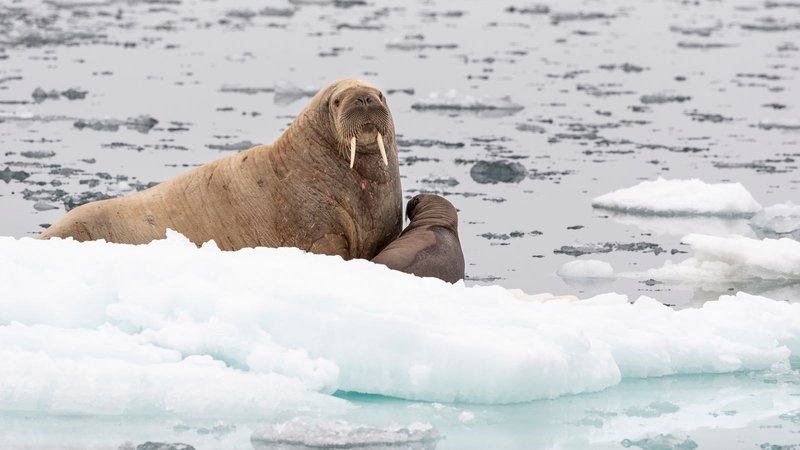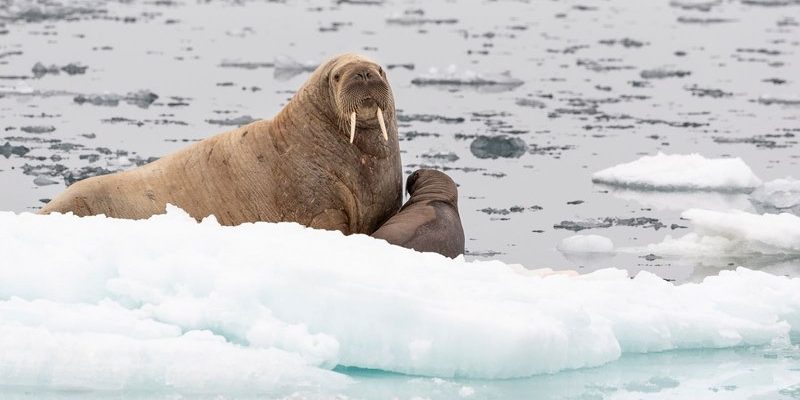
In this article, we’ll dive into the various ways climate change is affecting walruses, from their habitats to their health. We’ll look at the science behind these changes, the impact on their populations, and what we might be able to do to help them. So grab a comfy seat and let’s explore this topic together!
Walruses: A Brief Overview
Walruses are fascinating creatures. They’re known for their long tusks, whiskered snouts, and large bodies, weighing up to 2,000 pounds! These marine mammals primarily inhabit the icy waters of the Arctic and sub-Arctic regions. They spend most of their time on sea ice or beaches, where they haul out to rest, breed, and give birth.
One of the most remarkable things about walruses is their social behavior. They often gather in large groups, sometimes numbering in the thousands. This social structure is vital for their survival, as it provides safety in numbers and helps them raise their young. However, as climate change alters their environment, these social dynamics could be at risk.
Melting Ice: The Walrus’s Home Under Threat
You might be wondering why ice is so crucial for walruses. Well, sea ice serves as a platform for them to rest, hunt, and give birth. As climate change warms our planet, polar ice caps are melting at an alarming rate. This loss of ice impacts walruses in several ways.
First, without sufficient sea ice, walruses are forced to swim longer distances to find food like clams and other benthic organisms. This not only requires more energy but can also lead to malnutrition. Imagine if you had to walk for miles just to find your next meal—you’d be exhausted!
Second, melting ice can lead to overcrowding on beaches, especially during breeding seasons. When too many walruses gather in one spot to rest, it can create stress and competition for space. This can be particularly dangerous for mothers and their pups, as they need a safe environment to care for their young.
Changing Habitats and Food Sources
As the climate warms, the habitats walruses rely on are changing. The ocean temperatures are rising, which can affect the distribution of their prey. Walruses primarily feed on benthic animals, like clams, which thrive in colder waters. As waters warm, these food sources may migrate to deeper, cooler areas, making it harder for walruses to find them.
Here’s a fun fact: walruses can dive up to 300 feet deep to forage for food! But if their food moves to depths that are too challenging for them, it could lead to declines in their populations. Picture a pantry slowly disappearing—eventually, there’s nothing left to eat.
Furthermore, as ice melts and habitats shift, walruses are increasingly coming into contact with human activities, like shipping and oil exploration. This can increase stress levels, decrease food availability, and lead to dangerous encounters.
Health Risks Linked to Climate Change
Climate change doesn’t just affect walrus habitats; it also impacts their health. As their habitats change, walruses are more susceptible to diseases and parasites. Warmer temperatures can create ideal conditions for harmful bacteria and pathogens, which can pose a serious risk to their health.
Additionally, the stresses of overcrowding and competition can lead to physical injuries and increased mortality rates. Imagine living in a crowded apartment with no personal space—eventually, the stress can take a toll on your well-being. That’s exactly what walruses are experiencing as their living situations become more complicated.
Impact on Walrus Populations
So, what does all of this mean for walrus populations? With their habitats shrinking, food sources dwindling, and health risks increasing, walruses are facing a tough future. Current estimates suggest that some populations are declining, prompting concern among researchers and conservationists.
The most significant populations, like the Atlantic walrus and Pacific walrus, have shown signs of stress due to climate change. This could lead to changes in breeding patterns, lower birth rates, and ultimately, a drop in the overall numbers of walruses. If we don’t take action, we could be witnessing a decline in an iconic species of the Arctic.
What Can Be Done to Help Walruses?
Here’s the good news: there are ways we can help walruses cope with the challenges posed by climate change. First and foremost, addressing climate change on a global scale is crucial. By reducing greenhouse gas emissions and advocating for cleaner energy sources, we can help slow down the warming of our planet.
Community education is another essential factor. Raising awareness about walrus habitats and the threats they face can inspire more people to take action. Simple steps, like reducing plastic use and supporting conservation efforts, can have a significant impact on wildlife.
We can also support organizations working on the ground to protect walrus populations and their habitats. By championing local conservation efforts, we can help ensure these magnificent animals have a fighting chance in an ever-changing world.
In conclusion, walruses are more than just cute, blubbery creatures; they are an important part of the Arctic ecosystem. Climate change is making life increasingly difficult for them, affecting their homes, health, and populations. But it’s not too late to make a difference. By understanding the challenges they face and working together to fight climate change, we can help protect walruses and their environment.
Let’s take a moment to appreciate the beauty of these incredible animals and remember that our actions today can shape a better future for them tomorrow. After all, we share this planet, and it’s our responsibility to care for it—for both walruses and ourselves.

